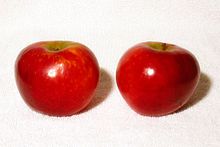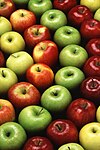
'Pinova' is a German apple cultivar. It was created in 1965 at the Institut für Obstforschung of Dresden–Pillnitz in Saxony which at that time was in the German Democratic Republic. After Germany was re-united in 1990, the rights to the cultivar passed to the Free State of Saxony.
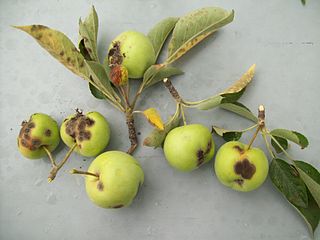
Apple scab is a common disease of plants in the rose family (Rosaceae) that is caused by the ascomycete fungus Venturia inaequalis. While this disease affects several plant genera, including Sorbus, Cotoneaster, and Pyrus, it is most commonly associated with the infection of Malus trees, including species of flowering crabapple, as well as cultivated apple. The first symptoms of this disease are found in the foliage, blossoms, and developing fruits of affected trees, which develop dark, irregularly-shaped lesions upon infection. Although apple scab rarely kills its host, infection typically leads to fruit deformation and premature leaf and fruit drop, which enhance the susceptibility of the host plant to abiotic stress and secondary infection. The reduction of fruit quality and yield may result in crop losses of up to 70%, posing a significant threat to the profitability of apple producers. To reduce scab-related yield losses, growers often combine preventive practices, including sanitation and resistance breeding, with reactive measures, such as targeted fungicide or biocontrol treatments, to prevent the incidence and spread of apple scab in their crops.

Jonagold is a cultivar of apple which was developed in 1953 in New York State Agricultural Experiment Station of Cornell University's College of Agriculture and Life Sciences, a cross between the crisp Golden Delicious and the blush-crimson Jonathan; the name Jonagold is a portmanteau of these two variety names. They form a large sweet fruit with a thin skin. Because of their large size they are now favoured by commercial growers in many parts of the world. Jonagold is triploid, with sterile pollen, and as such, requires a second type of apple for pollen and is incapable of pollenizing other cultivars. The Jonagored Apple, a sport mutation of Jonagold, was once covered under United States Patent PP05937, now expired.
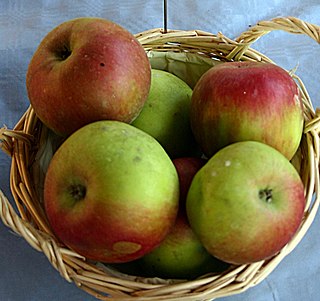
Idared is a type of apple cultivar from Moscow, Idaho, United States. Variety is characterized by a non-uniform skin color.
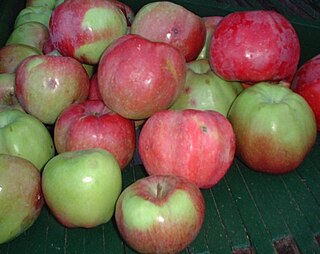
The Northern Spy, also called 'Spy' and 'King', is a cultivar of domesticated apple that originated on the farm of Oliver Chapin in East Bloomfield, New York in about 1840. It is popular in upstate New York.

The Elstar apple is an apple cultivar that was first developed in the Netherlands in Elst in the 1950s by crossing Golden Delicious and Ingrid Marie apples. It quickly became popular, especially in Europe and was first introduced to America in 1972. It remains popular in Continental Europe, but less so in the United Kingdom.
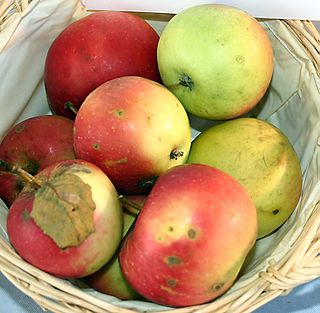
The Jonathan apple is a medium-sized sweet apple, with a touch of acid and a tough but smooth skin. It is closely related to the Esopus Spitzenburg apple, good for eating fresh and for cooking. Sugar 14%, acid 9g/litre, vitamin C 5mg/100g.

Venturia inaequalis is an ascomycete fungus that causes the apple scab disease.

Empire is the name of a clonally propagated cultivar of apple derived from a seed grown in 1945 by Lester C. Anderson, a Cornell University fruit nutritionist who conducted open pollination research on his various orchards. In 1945, under the direction of A. J. Heinicke, scientists from the New York State Agricultural Experiment Station of Cornell University in Geneva, New York, harvested the Empire seed together with thousands of its siblings. The Geneva teams grew and tested ever dwindling sub-populations of the sibling group until 1966, when the final selection, the Empire, was released to the public at the New York Fruit Testing Association meetings in Geneva. According to the US Apple Association website it is one of the fifteen most popular apple cultivars in the United States.

An apple is an edible fruit produced by an apple tree. Apple trees are cultivated worldwide and are the most widely grown species in the genus Malus. The tree originated in Central Asia, where its wild ancestor, Malus sieversii, is still found today. Apples have been grown for thousands of years in Asia and Europe and were brought to North America by European colonists. Apples have religious and mythological significance in many cultures, including Norse, Greek, and European Christian tradition.
The Golden Orange apple is an apple cultivar that was first developed in Italy in the 1970s by crossing PRI 1956-6 and Ed Gould Golden apples.

Liberty is a hybrid apple cultivar developed by the New York State Agricultural Experiment Station. It was a seedling produced in 1955 from pollinating 'Macoun' from 'Purdue 54-12' for the sake of acquiring Malus floribunda disease resistances. It was first released to the public in 1978.

Lord Lambourne is an apple cultivar with a sweet sharp flavor. It was raised by Laxtons Brothers Ltd in 1907 in Bedford, England. It is a holder of the Royal Horticultural Society Award of Garden Merit
Applecrabs are various hybrids between crabapples and apples. They are bred for varying reasons, including disease resistance and use in cold climates because they are often hardier than apple trees and their fruit has the good eating qualities of apples.

Pristine apple is a hybrid cultivar of 'Co Op 10' x 'Camuzat' domesticated apples, which are descendants of the 'McIntosh' apple and the 'Starking Delicious'. This cultivar was developed and patented in the United States by the PRI disease resistant apple breeding program, in Indiana, United States in 1994, for its resistance to apple scab. It is susceptible to cedar-apple rust.
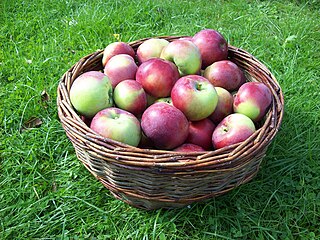
'Birgit Bonnier' is a modern cultivar of domesticated apple which have some resistance to apple scab and mildew.

'Delbard Jubilée' or 'Delgollune' is a modern French cultivar of domesticated apple which was developed in 1964 by Delbard nurseries. It is not the same as the Jubilee apple that was developed in Canada.
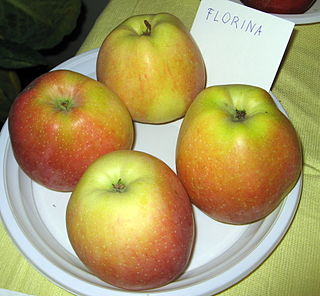
Florina which is also called Querina, is a French cultivar of domesticated apple, that has combined traits of the Jonathan, Golden Delicious and Rome apples, and was developed in Angers, France, by the "Station de Recherches d'Arboriculture Fruitiere". Although developed in France its ancestry is entirely American.
Enterprise is a modern bred, late-ripening and attractive, red cultivar of domesticated apple with excellent fruit quality combined with disease resistance to scab, cedar apple rust, fire blight and some resistance to powdery mildew. The fruit is large and attractive and retains excellent fresh quality for up to six months at 1°C. Its moderate acidity at time of harvest mellows in storage, and it is best after one month of storage.

The 'Prima' apple is one of the modern disease resistant cultivars of domesticated apple which was bred by the PRI disease resistant apple breeding program in 1958. The disease resistance against apple scab has since been broken.
